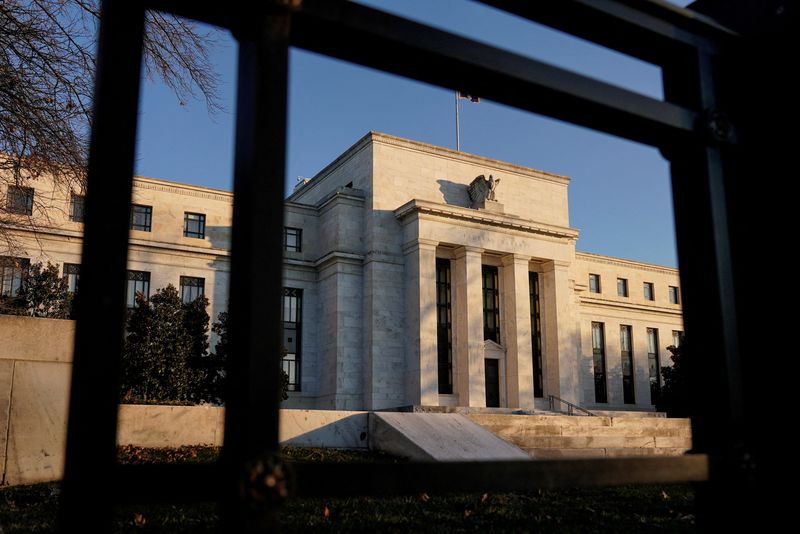NEW YORK (Reuters) - All participants at the Federal Reserve's May 3-4 policy meeting backed a half-percentage-point rate increase to combat inflation they agreed had become a key threat to the economy's performance and was at risk of racing higher without central bank action, newly released minutes of the session showed.
The 50-basis-point rate increase this month was the first of that size in more than 20 years, and has set the Fed on course for a quick tightening of monetary policy, with "most participants" judging that further half-percentage-point increases would "likely be appropriate" at upcoming Fed sessions in June and July, according to the minutes, which were released on Wednesday.
STORY:
MARKET REACTION:
STOCKS: The S&P 500 extended gains to +0.75%
BONDS: The yield on the 10-year Treasury note slipped to 2.7577%. The 2-year note yield ticked up to 2.5161%
DOLLAR: The US dollar index eased back to a gain of 0.39%
COMMENTS:
EDWARD MOYA, SENIOR MARKET ANALYST, THE AMERICAS, OANDA, NEW YORK (emailed)
"US stocks edged higher as investors anticipate a quickly weakening economy will force the Fed into tapping the breaks with their tightening cycle. The FOMC minutes are over three weeks old, but they did give a glimmer of hope that they could adjust their policy tightening stance later in the year. The Fed mostly sees 50 basis point increases appropriate at the next couple of meetings as they are behind the curve with fighting inflation. The Fed is optimistic about the economy, but they are growing concerned with markets for Treasuries and commodities."
MICHAEL JAMES, MANAGING DIRECTOR OF EQUITY TRADING, WEDBUSH SECURITIES, LOS ANGELES
"Given all the negativity we've been dealing with for the last several weeks this is at least initially an exhale of relief that commentary wasn't far more hawkish."
"All of this has to be taken with a grain of salt and keeping in mind that these are backward looking comments.”
"The Fed has a very difficult line to try and walk between wanting to stifle inflation and not wanting to too negatively impact the economy."
BOB MILLER, HEAD OF AMERICAS FUNDAMENTAL FIXED INCOME, BLACKROCK (emailed)
"The FOMC meeting minutes released today don’t provide us with any new policy information, but details of the discussion around the table do allow us to glean some insight into the Committee’s thinking on the forward path. Specifically, it’s very clear that bringing down inflation was (and is) the focus at the Fed’s May meeting; Chair Powell has reinforced the need to expeditiously raise rates toward broad estimates of neutral, as risks to inflation still tilt to the upside. As such, the Chair has already laid out a base case of 50 basis point (bps) policy rate hikes at the June and July meetings and other Fed speakers have endorsed this view.
"We think that after the July meeting the Fed is likely to become more “data dependent” with regard to rate hikes, which essentially means that the policy path after July will depend upon (a) the trajectory of inflation and (b) progress toward correcting the supply/demand imbalances in the labor market. In our view, if those factors are “improving” (which is to say lower levels of inflation and reduced labor market imbalances), then the Fed gains some breathing room and can shift policy adjustments to 25 bps increments, while still pursuing something in the estimated range of neutral. This path would likely result in reduced market volatility and a lower probability of an economic hard landing. However, if those factors are not improving after the July FOMC meeting, then the Fed will likely be forced to continue to adjust policy in 50 bps increments, which would support continued high levels of market volatility and would increase the probability of unfriendly economic outcomes. Further, in that second scenario, consideration of 75 bps hikes may come back on the policy table."
RICK MECKLER, PARTNER, CHERRY LANE INVESTMENTS, NEW VERNON, NEW JERSEY

“At this point for the market to really rally it needs some indication that the Fed has taken into account what is going on and is either really slowing the pace or changing things and that is just not the way they have typically have done it. They have tended to be very gradual in their guidance, I just don’t think there is enough there. On the positive side though, it wasn’t extremely hawkish, it was in some ways just a more moderate reflection of what is going on right now, a combination of inflation and what is probably a slowing economy.”
“The market looks ahead and their feeling is that the worst of the inflation news may be behind us. Obviously a wild card is energy prices, Russia and Ukraine, that would be one significant change. But otherwise I think the market is looking to stabilize here and looking a little bit forward to the point where the Fed can start to issue some different guidance and say the economy has slowed enough that they don’t see the need to continue to raise rates.”